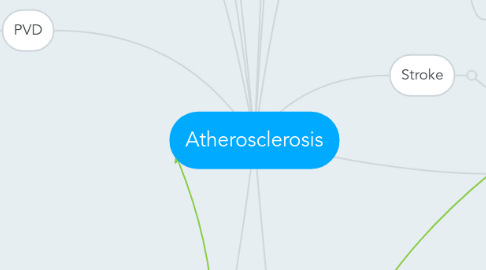
1. PVD
1.1. PAD
1.1.1. claudication=pain w exercise, relieved by rest
1.1.2. occlusion
1.1.2.1. 6 P's: Pain, pallor, pulselessness, poikilothermia, paresthesia, paralysis
1.2. DVT
1.2.1. Virchow's triad
1.2.1.1. Venous stasis, venous endothelial change, hypercoagulability
1.2.1.1.1. D-Dimer plasma level
1.3. Varicose Veins
1.3.1. saphenous v. most affected, issue w valves
1.4. Chronic Venous Insufficiency
1.4.1. the progression of varicose veins, blood clot formation and pooling due to stasis of flow
2. Hyperlipidemia
2.1. LDL (carry cholesterol to body cells)
2.1.1. Liver -> IDL -> LDL
2.1.1.1. only one w ApoB-100 (drugs can target this)
2.2. HDL (remove cholesterol from circulation)
2.2.1. Liver- donates ApoC-II to chylomicrons (from intestine) and to VLDL + lipoprotein lipase -> FFA to be uptake by muscle & adipose tx
2.3. VLDL
2.3.1. from Liver
2.4. TG
2.5. Drugs
2.5.1. **Statins
2.5.1.1. First-line
2.5.1.1.1. atorvastatin- can take any time of day. most others take at night.
2.5.1.1.2. rosuvastatin and pravastatin are not metabolized by CYP
2.5.1.2. dec. LDL: competitively inhibits Hmg-CoA (rate-limiting enzyme in synthesis of chol.)
2.5.1.3. Pleiotropic effects (dec LDL oxidation, inc. fibrinolysis, dec. circ inflammation markers, dec. remodeling), Myopathy, hepatotoxicity
2.5.2. Niacin
2.5.2.1. inc. HDL, dec. lipoprotein
2.5.2.2. flushing, vasodilation, hyperglyc., hyperuricemia (gout)
2.5.3. Fibrates
2.5.3.1. Dec. TG: PPAR-alpha, inc HDL and inc. activity lipoprotein lipase (=more lipid uptake)
2.5.3.1.1. treat hypertriglyceridemia
2.5.3.2. myopathy, gallstones
2.5.3.2.1. Gemfibrozil- do NOT take w statins
2.5.4. Bile-acid Resins
2.5.4.1. Dec LDL: binds to bile in gut (Chole-)
2.5.4.2. abd. discomfort, tastes bad, gallstones
2.5.4.2.1. Folate supplementation may be needed.
2.5.5. Ezetimibe
2.5.5.1. Cholesterol Absorption Inhibitors: selectively inhibits int. absorption, liver takes up more LDL from circulation
2.5.5.1.1. used in combo with Statins
2.5.5.2. diarrhea
3. Testing
3.1. Doppler for patency and systolic pressure
3.2. ankle-brachial index
3.3. CTA/MRA
3.4. Intravascular ultrasound
3.5. atherosclerosis
4. epidemiology
4.1. 4 xs more likely in men
4.2. most common cause of cardiovascular death
5. risk factors
5.1. smoking
5.2. familial
5.3. diet
5.4. inactivity
5.5. diabetes
5.6. dyslipidemia (high LDL, low HDL)
6. HTN
6.1. Essential
6.1.1. no primary cause. 90% of those w htn
6.1.1.1. > in black. men and women the same.
6.1.2. pathophysiology
6.1.2.1. overactive SNS
6.1.2.1.1. inc prod. of catecholamines (epi and norepi) and inc neuroreceptor activity
6.1.2.2. overactive RAAS
6.1.2.2.1. Na and water retention. inc. Angiotensin II production- endothelial dysfunction, insulin resistance, dyslipidemia, platelet aggregation, arterial remodeling.
6.1.2.3. dysfunction of natriuretic peptides: ex. BNP- lead to renal vasoconstriction and tx ischemia
6.2. Secondary
6.2.1. caused by an underlying disease/cause increasing PVR or CO
6.2.1.1. pregnancy, coarctation of aorta, oral contraceptives
6.2.1.2. renal parenchymal htn- most common cause of secondary htn
6.2.1.3. early onset htn (< 30) w/o other risk factors
6.3. often asymptomatic, "silent killer"
6.4. Aortic dissection
6.4.1. often from prolonged HTN
6.4.1.1. intimal tear allows blood into false lumen
6.5. HTN urgency: systolic > 220 diastolic > 125
7. Stroke
7.1. carotid stenosis- 1/2 of strokes
8. MI
8.1. S/S
8.1.1. Angina
8.1.1.1. stable angina
8.1.1.2. unstable angina
8.1.1.3. variant angina
8.1.2. pyrosis=heartburn
8.1.3. referred pain: lower jaw, inside L arm, upper back,
8.1.4. dyspnea
8.1.5. diaphoresis
8.1.6. nausea/vomiting
8.1.7. women: sharp pain, fatigue, weakness
8.1.8. 25% have no symptoms
8.2. prolonged ischemia, irreversible cell death.
8.3. 90% caused by atherosclerosis
8.4. epidemiology
8.4.1. predominantly males
8.4.2. most patients > 60
8.5. Types
8.5.1. STEMI
8.5.1.1. total occlusion of major coronary artery
8.5.1.1.1. L coronary a. = "widow maker"
8.5.2. NSTEMI
8.5.2.1. total occlusion of minor artery or partial occlusion of major coronary artery
8.6. Testing
8.6.1. troponin (T and I), creatine kinase, myoglobin, c-reactive protein
8.6.2. EKG
8.6.2.1. STEMI
8.6.2.1.1. ST elevation
8.6.2.2. NSTEMI
8.6.2.2.1. no ST elevation, look to troponin levels
8.6.2.3. old MI, pathological Q wave, inverted T wave
8.6.3. Echocardiogram
8.7. Treatment
8.7.1. Reperfusion Therapy
8.7.1.1. STEMI
8.7.1.2. w/in 12 hrs of onset.
8.7.1.3. thrombolysis
8.7.1.4. PCI (percutaneous coronary intervention) door to drug time-30 min. door to surgery time-90 min.
8.7.2. MONA (Morphine, O2, Nitrogen, Aspirin)
8.7.3. Beta Blockers
9. Pathophysiology
9.1. 1. Injury endothelial cells
9.2. 2. LDL deposits in tunica intima and becomes oxidized
9.3. 3. Adhesion of leukocytes and T-cells activated
9.4. 4. monocytes enter intima and become macrophages, digest LDL ->Foam cells
9.5. 5. Inc. smooth muscle cell proliferation and synthesis of collagen and fibrin. calcification = plaque cap. Inc. inflammation
9.6. 6. Foam cells dies, lipid content release-Thrombosis
10. CAD
10.1. often at bifurcation, inc. in shear stress= weakening in vessel
10.2. BNP, CRP, homocysteine, urinary albumin-creatine ratio
10.3. may have xanthelasmas (yellow crusty in eyes)
11. Treatment
11.1. Smoking cessation
11.2. DASH diet
11.3. Cardiovascular exercise
11.4. Control of diabetes
11.5. HTN control
11.6. Angioplasty and stenting
11.7. Coronary artery bypass graft
11.7.1. internal mammary artery
11.7.2. saphenous v.
